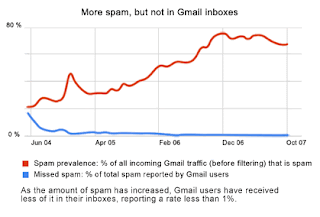When Gmail's spam filters are working perfectly, no one talks to us anti-spam engineers. But as soon as something goes wrong, our users, our friends, and even our Google colleagues who use Gmail for their corporate mail are sure to tell us. That's just the way we like it. Spam is not something people should grow numb to and accept as a fact of life. We *want* people to complain. That's the only way things get better.
Due in large part to all the great feedback we get, things are better. We're keeping more spam out of your inbox than ever before, so more and more, you can use Gmail for things you enjoy without even realizing that the spam filter is there most of the time. It's not too different from driving a convertible down the freeway with the top down, with the wind blowing through your hair and no traffic jams to destroy the mood. Now, I'm not saying we're perfect, but the really good news is that it seems like spammers are finally starting to get discouraged. Attempts to spam Gmail users have been leveling off over the last year and more recently, even declining slightly. We

As much as we don't want you to even think about spam, people are naturally curious and ask questions such as "where does spam come from?", "who buys the shoddy stuff spammers advertise?" and "how do you catch spam?" We're engineers, though, not forensic experts or economists, so while we can only speculate about the first two questions, we can talk authoritatively about the last one -- spam-catching. To that end, we've put together a video explaining how our spam filters work:
Now if we could only get a "Report Traffic" button in our cars ...